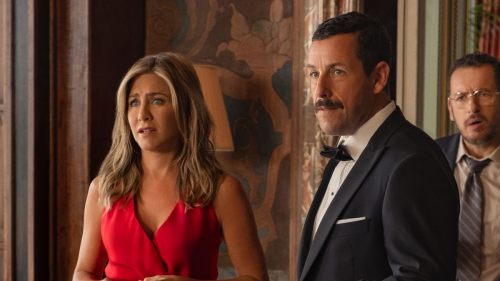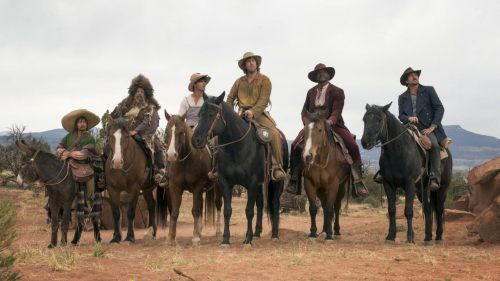Hell’s Kitchen: A Weird Setting For Netflix’s DAREDEVIL
Hell's Kitchen is an outdated nickname for Manhattan's middle West side. The area stretches pretty much from 37th Street to 57th Street, and it includes everything west of 8th Avenue up to the water. It's the home of Matt Murdock, also known as Daredevil. When the first issue of that comic hit the stands, way back in 1964, the neighborhood was a seething hot bed of crime and ethnic tension. FIfty years later and Hell's Kitchen is an upscale, gentrified area that would no longer welcome Matt's down on his luck boxer dad, Battlin' Jack Murdock. A successful lawyer, blind or otherwise, might live there, though.
It's not clear who first called it Hell's Kitchen. It was an Irish slum for a long time, and maybe it got its name from what Davy Crockett said about another New York Irish slum, the infamous Five Points (see Gangs of New York): "In my part of the country, when you meet an Irishman, you find a first-rate gentleman; but these are worse than savages; they are too mean to swab hell's kitchen." Other stories say that the name came from beat cops who sort of patrolled the area (they mostly looked on as violence occured). One rookie cop, seeing a terrible beating being administered to a man, cried out, 'This place is Hell!" His older partner replied, "Hell is cool. This place is Hell's Kitchen."
Or maybe it got it's name from a rookery - what they used to call dilapidated, densely packed, rickety wooden slums at the time - that had the colorful name Hell's Kitchen. There were rookeries with equally colorful names - a September 1881 New York Times article talks about The Barracks and Battle Row and House of Blazes, so named because the residents would, for fun, light unconscious drunks on fire. Hell's Kitchen may simply have been one of those rookeries and, as the upper class began to take notice of the vlle situation on the West Side, its name became synonymous with the entire area.
The West Side was originally blighted by the rail road, which brought with it slaughter houses (the meat could be easily shipped) and industrial activity. Soap rendering plants spilled fat out into the streets, which was a touch nicer than the blood that flowed freely from the abbatoirs. Children splashed in puddles of the stuff.
The Irish and the Germans settled the West Side. The Irish weren't even seen as technically white people at the time, but they certainly didn't equate themselves with blacks. When the Draft Riots started - Irish New Yorkers furious at being forced to fight the Civil War in order to emancipate blacks - most of the Hell's Kitchen area was barricaded by rioters. Dozens of black New Yorkers were hung from light posts in those violent days.
Walking through Hell's Kitchen during non-riot times wasn't much safer. In the 1880s the territory was ruled by a gang called The Gophers, who would pop out of basement staircases and mug passerby. If you were a stranger walking down the streets of Hell's Kitchen you needed to keep an eye to the rooftops, as it was a popular sport to drop rocks and paving stones on the heads of people who didn't belong. At the end of the 19th Century Hell's Kitchen was known as the most dangerous place in America, a murderous hellhole of depraved Irishmen and bloodthirsty Cossacks. You get the sense they liked that image - they certainly worked hard enough to keep it.
Things only got worse in the 20s when Prohibition hit. The neighborhood became a center of illegal brewing; the warehouses and tanneries made for perfect hiding spots to create shitty beer and rotgut gin. Owney Madden, a fiendishly violent member of The Gophers, battled his way to the top ranks of the West Side gangs and helped bring them together to form real organized crime. He was a flamboyant figure, owning the famous and historic Cotton Club. But the repeal of Prohibition shook his empire, and the organized gangs drifted away from the West Side. Then the construction of the Lincoln Tunnel devastated the neighborhood, as did the decline in shipping.
The Hell's Kitchen image at the top is by Jacob Riis, sometime at the end of the 19th century.
By the late 1950s Hell's Kitchen was still a slum, but now it was the Irish and the Puerto Ricans battling for dominance, and in 1959 the whole city took notice when the Capeman murders happened. Salvador Agron was a 16 year old Puerto Rican boy who had joined the gang The Vampires; he went with the gang to a rumble in Hell's Kitchen, intending to fight the Irish gang The Norsemen. When they got to the park there was a case of mistaken identity and two random, innocent boys were stabbed to death by Agron, who was wearing a Dracula cape (thus Capeman). Agron was sentenced to death, the youngest death row prisoner in American history, but appeals for clemency - including from Eleanor Roosevelt and the father of one of the slain boys - helped Agron get his sentence commuted.
This is the Hell's Kitchen into which Daredevil was born. Matt Murdock as an Irish-American made perfect sense; by 1965 the entire neighborhood was controlled by The Westies, a hyper-violent Irish gang tied to the Gambino crime family. When Stan Lee and Bill Everett created the character his background was all but a fait accompli, and having him patrol Hell's Kitchen, a neighborhood with a hundred plus years of bad PR, automatically delineated the stakes and the milieu. While other heroes would patrol the whole city, world or universe, Daredevil battled crime on a street level in the neighborhood in which he was born, a neighborhood that had been a criminal shit pit since the 1850s at least.
But fast forward fifty years and Hell's Kitchen isn't Hell's Kitchen anymore. Crime in general is down in New York City, but the West Side in particular has become gentrified and made more upscale. The neighborhood was redubbed Clinton in 1959, but it really caught on with real estate agents in the late 1990s, as the Guiliani regime created sweeping changes in the city.
Which brings us to 2015, the year in which Netflix's Daredevil show will debut. It will feature a Matt Murdock, aka Daredevil, fighting crime - and specifically the Kingpin of Crime - in Hell's Kitchen. But what does that look like today? The Westies are gone. The neighborhood is full of upscale restaraunts, hoity toity bars, happening clubs, Starbucks locations and expensive brownstones. If Matt Murdock is in his late 20s or early 30s in the TV show his Irish family would have been one of the last left in the neighborhood. The Westies were broken in the mid-80s, which is about when Murdock would have been born. The neighborhood's rise would have coincided with Murdock's maturation - every day he lived he would have seen his neighborhood improving (well, heard it anyway).
Of course that's assuming the Hell's Kitchen of the Marvel TV Universe is like ours; there's no reason that Daredevil can't live in a reality unlike our own, a Hell's Kitchen that recalls the old days as opposed to one that reflects the truth. But even if that were the case, Daredevil ends up being a series of missed opportunities before one scene has been shot. The changing demographics of Hell's Kitchen make Matt Murdock's Irish background an anomaly; it would have made more sense to hire a Hispanic actor for the role. While fans complain about changing the race of comic characters in adaptations, this is one of the times when the original race is actually more unrealistic than a bent race.
I'll be excited to watch Netflix's Daredevil show from a purely narrative standpoint, but I'll always have in the back of my mind the realization that the most outlandish aspect of the show might be the setting and the lead character's background.
The image of Hell's Kitchen up top is by Jacob Riis, taken sometime in the 1890s. The second image is 47th & 9th, today, taken from Google Maps Street View.



